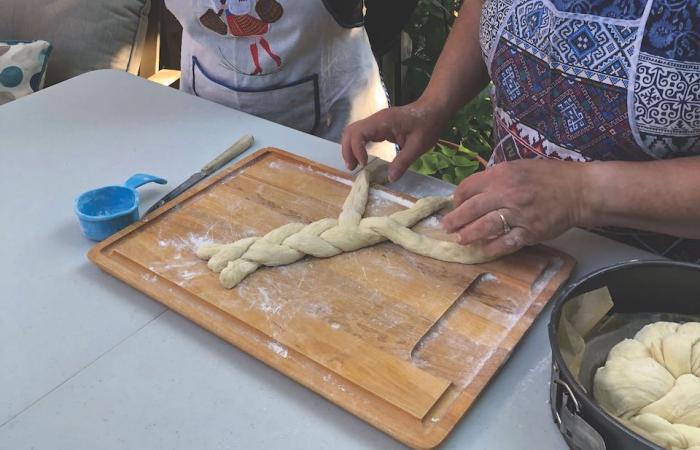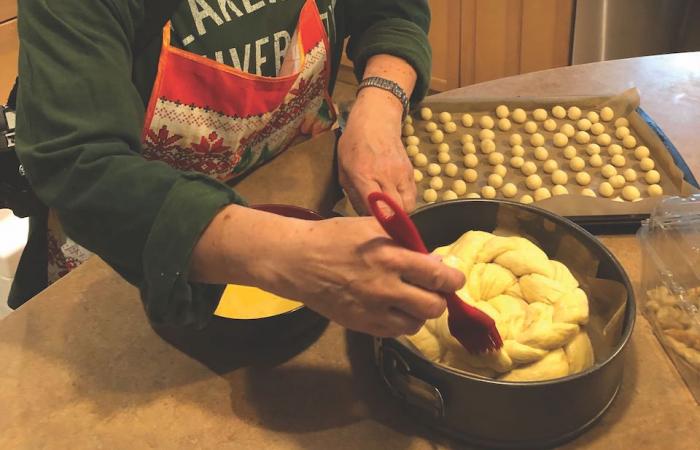If a group of Ukrainian women invite you to an evening of bread making, don’t expect to sip tea and watch the dough rise.
Especially if you’re making korovai wedding bread.
Cathy Paroschy Harris, founder and leader of the Korovai Kollective – a group of women of Ukrainian heritage – hosts these bread making parties at her house to keep the tradition alive and to pass it on to the next generation. It’s an evening of laughter, great times, and busy work –leaving little time to watch the dough rise. And there’s no tea – just wine!
Korovai wedding bread origins go back many centuries and while the traditions may vary from region to region and family to family, the symbolic gesture of sending good wishes and many blessings to the newlyweds remains the same.
While the family members and friends of the bride and groom gather to make the bread, there must be only good thoughts and happy times. No gossip. No ill news. No idleness. Traditional songs are sung, the wine flows, and as the evening progresses, the laughter grows much like the bread dough as it rises.
The preparation of korovai embodies a Ukrainian community’s blessings for a couple’s wedding. And rightfully so – it takes a community to make it! Not only does the bread dough need to be made, the layers of “cake” must be braided and many decorative pieces must be fashioned if the cake is to be of any value. The more decorative the cake, the happier the marriage will be.
The bread is full of symbolism.
The braided rings that constitute the main part of the bread represent eternity and everlasting life, while the decorative pieces symbolize all of those blessings that are essential to a good marriage. Roses denote beauty, ears of wheat signify prosperity, pinecones represent fertility, and a sprig of myrtle (myrt) and a wreath of periwinkle (barvinok) are added to show the strong connection that will bind the couple together. Two doves sit on top of the bread to symbolize the bride and groom. Other doves on the korovai represent the community that supports the couple in their life ahead.
At a Ukrainian wedding, although there are some variations, two korovai are brought to the front of the church by the couples’ Godparents and laid at the altar. After the wedding, the cakes are carried to the reception and set in a place of honour. During the reception, the newlyweds grab onto the bottom section (pidoshva) of the bread and begin an amusing tug-of-war. This results in a lot of cheering and laughter by attendees as the couple then pull the bread apart to see who will have the biggest piece and be considered the head of the household. The korovai can be eaten at the wedding or at the day-after party, or dried as a keepsake.
On the evening when I attended a gathering of the Korovai Kollective nothing was left to chance. Hours were spent fashioning flowers, leaves, doves, and pine cones to add to the wedding bread. When it comes to blessing a wedding, you can never go overboard.
Many of the ladies wore their traditional Ukrainian outfits and some wore khustky, the colourful scarves you often see Ukrainian women wearing on their heads. Snippets of conversation in Ukrainian grew louder and louder, and every once in awhile someone would break out in a traditional Ukrainian song and the rest would join in.
It was like everyone was back in Ukraine, but during happier times. It was beautiful.
In the middle of a war that is destroying their homeland, these women made happiness their strength and fellowship their hope for their country. It was a perfect blessing for the newly weds!
Cathy is happy to share her recipe for Korovai wedding bread with Bayview readers. But anyone making Ukrainian wedding bread will tell you that the dough is only a small part of the experience – it’s the braiding and creation of the decorative pieces that brings the bread to life – so to speak.
The best way to learn how to braid and fashion doves and flowers out of dough is to learn from someone else – perhaps at a korovai wedding bread party! – but if this isn’t possible there are some great tutorials on the internet, including these sites: suburbangrandma.com or Folk Arts & Demonstrations: Korovai and Dough Art with Olga Orleski on YouTube.
Ingredients
- 1 Tbsp dry yeast
- 5 cup water
- 1/2 cup sugar
- 4 eggs, beaten
- 1 Tbsp salt
- 3/4 cup vegetable oil or melted butter
- 12 cup flour, more for kneading
- 1 tsp vanilla, saffron, cardamon or orange/lemon zest (optional flavourings)
Method
- Soak yeast in 1/2 cup warm water and 1 Tbsp sugar for about 10 minutes
- Combine eggs, sugar, salt and oil then beat well
- Add the yeast mixture and stir well.
- Add the water and flour then knead about 10 to 15 minutes
- Cover and let rise in a warm place until double in size. Punch down every 20 minutes (about 4 times)
- Grease well or line with parchment paper 4 or 5, 8-inch round pans (3” high)
- Divide the dough for 4 to 5 loaves. Prepare each loaf by braiding a round shape, tucking and pinching the ends underneath, setting each in a pan. Use several smaller braids for different effects. Cover loaves with cloth and set in warm place to rise until double in size, approximately 1 hour
If you wish to use the same yeast dough for decorations, note that they will continue to rise and potentially lose their shape in baking. Alternatively, make a different dough with flour, cornstarch, water and oil to shape and arrange the ornaments on top of round loaves after baking or mid-baking. Gently brush tops of risen dough with beaten egg diluted with 1 Tbsp water. Bake at 400°F for 20 minutes (this high temperature stops the yeast from further rising and losing the braided shape), then turn down to 350°F and continue baking 35 to 40 minutes. If making smaller loaves, decrease this time. The bread will sound hollow when tapped on the underside when it is done, and will have a nice golden colour.





